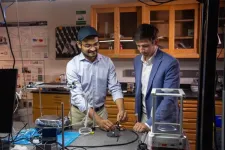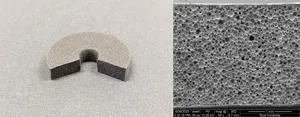(Press-News.org) HOUSTON – (July 24, 2024) – When picturing next-generation wearables and robotics, the foam filling in your couch cushions is likely not the first thing that comes to mind.
However, Rice University engineers have shown that something as simple as the flow of air through the airy, meshlike structure of open-cell foam can be used to perform digital computation, analog sensing and combined digital-analog control in soft textile-based wearable systems.
“In this work, we integrated material intelligence — the ability of materials to sense and respond to their environment — with circuit-driven logic using a surprisingly simple approach based on the flow of fluid through soft foams,” said Daniel Preston, assistant professor of mechanical engineering and corresponding author on a study about the research published in Advanced Functional Materials.
Pneumatic logic circuits in soft-bodied robots and wearables have been traditionally designed in ways that mirror electronic circuits, i.e. by linking together individual components such as resistors, capacitors, diodes and gates via connecting elements. Such conventional architectures rely on interconnected logic gates — basic building blocks in digital systems that turn one or more than one input into a single output.
In previous work, the Preston Innovation Laboratory developed a method for electronics-free control of textile wearables using pneumatic logic circuits. However, this initial approach did not rely on the properties intrinsic to soft materials in order to maximize circuit design efficiency.
“The more complex a task or operation, the greater the number of logic gates typically required,” Preston explained.
In applications, this could translate into devices that are heavier, more expensive and difficult to make and more susceptible to failure. To bypass the issue, the researchers figured out how to use pressure differences created by air flowing through the microscopic pores in foam sheets in order to perform complex pneumatic computations and control tasks with a greater economy of circuit design.
“Here, we show that the properties of soft materials themselves — such as the sponginess or porosity of foam sheets — can be leveraged to achieve fluidic control tasks such as sensing the amount of force applied by a user or converting digital pressure signals to analog signals, thereby reducing the reliance on fluidic logic gates and simplifying operation,” said Anoop Rajappan, lead author on the study and a research scientist at Rice during the course of the project.
Unlike liquids, the density of air changes with pressure, which makes the modeling of airflow through foam sheets more complex. Nonetheless, the researchers tackled the challenge head-on.
“We developed a theoretical framework for analyzing gas flow through porous materials, created new experimental techniques to measure the fluidic properties of foam and finally generated a model for the change in fluidic resistance of foam with applied force,” Rajappan said.
The researchers designed foam-based fluidic resistors — devices that restrict airflow in pneumatic circuits, much like how electronic resistors limit current flow in electronic circuits. The resistors can be used to create two-dimensional pneumatic logic circuits that can be embedded in textile-based wearable devices.
“By redesigning circuit components such as resistors to leverage the fluidic properties of soft materials such as foam, we can build reliable and streamlined soft robots and wearable devices powered by pneumatics that are less dependent on heavy, bulky or rigid components such as motors and batteries,” Rajappan said. “Wearable robotic devices could, for instance, provide assistance to users with mobility limitations, and building wearables out of textiles and powering them using compressed air can make them comfortable, lightweight, low-cost and unobtrusive for the user.”
In addition to Preston and Rajappan, other authors on the study include Zhen Liu, Faye Yap and Rawand Rasheed. Rajappan, Liu and Yap have accepted offers to tenure-track assistant professor positions at Tulane University, the University of Texas at Dallas and the University of Hawaii, respectively. Rasheed is CEO of Helix Earth Technologies, a startup spun out of Preston’s lab.
“Our work at Rice is making real contributions across multiple fields, and I am glad so many of our students continue to do so, in academia, industry and even their own companies, after training in our program,” Preston said.
The research was supported by the Rice Academy of Fellows, the U.S. Department of Energy (DE-SC0014664), the Shared Equipment Authority at Rice and the National Science Foundation (CMMI-2144809).
-30-
This news release can be found online at news.rice.edu.
Follow Rice News and Media Relations via Twitter @RiceUNews.
Peer-reviewed paper:
Embedded Fluidic Sensing and Control with Soft Open-Cell Foams | Advanced Functional Materials | DOI: 10.1002/adfm.202403379
Authors: Anoop Rajappan, Zhen Liu, Te Faye Yap, Rawand Rasheed and Daniel Preston
https://doi.org/10.1002/adfm.202403379
Image downloads:
https://news-network.rice.edu/news/files/2024/07/220822_preston-lab-mechanical-engineering_martin-14.jpg
CAPTION: Anoop Rajappan (left) and Daniel Preston (Photo by Brandon Martin/Rice University)
https://news-network.rice.edu/news/files/2024/07/foam-resistor-cross_section.jpg
CAPTION: Cross section of a foam-based fluidic resistor (left); microscope view of foam sheet cross section (right). (Image courtesy of the Preston Innovation Lab/Rice University)
https://news-network.rice.edu/news/files/2024/07/bending-actuator.jpg
CAPTION: Push button-activated foam-based fluidic actuator; varying levels of force cause corresponding levels of actuation. (Image courtesy of the Preston Innovation Lab/Rice University)
https://news-network.rice.edu/news/files/2024/07/Preston_digital-to-analog.jpg
CAPTION: Foam-based fluidic actuator controlled via integrated digital-to-analog converter.
(Image courtesy of the Preston Innovation Lab/Rice University)
https://news-network.rice.edu/news/files/2024/07/signal_transmission_fluidics.jpg
CAPTION: Foam-based fluidic circuits can be used to transmit data via haptic cues.
(Image courtesy of the Preston Innovation Lab/Rice University)
About Rice:
Located on a 300-acre forested campus in Houston, Rice University is consistently ranked among the nation’s top 20 universities by U.S. News & World Report. Rice has highly respected schools of architecture, business, continuing studies, engineering, humanities, music, natural sciences and social sciences and is home to the Baker Institute for Public Policy. With 4,574 undergraduates and 3,982 graduate students, Rice’s undergraduate student-to-faculty ratio is just under 6-to-1. Its residential college system builds close-knit communities and lifelong friendships, just one reason why Rice is ranked No. 1 for lots of race/class interaction, No. 2 for best-run colleges and No. 12 for quality of life by the Princeton Review. Rice is also rated as a best value among private universities by Kiplinger’s Personal Finance.
END
Foam fluidics showcase Rice lab’s creative approach to circuit design
Next-generation soft robotics and wearable technologies could sport foam-based fluidic circuits
2024-07-24
ELSE PRESS RELEASES FROM THIS DATE:
Montana State scientists publish evidence for new groups of methane-producing organisms
2024-07-24
A team of scientists from Montana State University has provided the first experimental evidence that two new groups of microbes thriving in thermal features in Yellowstone National Park produce methane – a discovery that could one day contribute to the development of methods to mitigate climate change and provide insight into potential life elsewhere in our solar system.
The journal Nature this week published the findings from the laboratory of Roland Hatzenpichler, associate professor in MSU’s Department of Chemistry and Biochemistry in the College ...
Daily rhythms depend on receptor density in biological clock
2024-07-24
In humans and other animals, signals from a central circadian clock in the brain generate the seasonal and daily rhythms of life. They help the body to prepare for expected changes in the environment and also optimize when to sleep, eat and do other daily activities.
Scientists at Washington University in St. Louis are working out the particulars of how our internal biological clocks keep time. Their new research, published July 24 in the Proceedings of the National Academy of Sciences, helps answer longstanding questions about how circadian rhythms are generated and maintained.
In all mammals, the signals for circadian rhythms come from a small part of the brain called the suprachiasmatic ...
New England Journal of Medicine publishes outcomes from practice-changing E1910 trial for patients with BCR::ABL1-negative B-cell precursor acute lymphoblastic leukemia
2024-07-24
A significant survival improvement for adults with newly diagnosed BCR::ABL1-negative B-cell precursor acute lymphoblastic leukemia is published today by the New England Journal of Medicine. The practice-changing finding is from the randomized phase 3 study E1910 (NCT02003222), which evaluated blinatumomab immunotherapy in patients who were in remission and tested negative for measurable residual disease (MRD) after an initial round of chemotherapy. At 3 years of follow-up, 85% of the patients who went on to receive additional standard consolidation chemotherapy plus experimental blinatumomab were alive, compared to 68% of those who received chemotherapy only.
Blinatumomab (Blincyto, ...
Older adults want to cut back on medication, but study shows need for caution
2024-07-24
More than 82% of Americans age 50 to 80 take one or more kinds of prescription medication, and 80% of them say they’d be open to stopping one or more of those drugs if their health care provider gave the green light, a new University of Michigan study shows.
But it’s not as simple as that, the researchers say. They call for prescribers and pharmacists to talk with older adults about their personal situation and figure out if any kind of “deprescribing” is right for them.
The study, published in the Journal of General Internal Medicine, uses data from U-M’s National Poll on Healthy Aging, and builds on a poll report issued in April 2023.
It ...
Nationwide flood models poorly capture risks to households and properties
2024-07-24
Irvine, Calif., July 24, 2024 – Government agencies, insurance companies and disaster planners rely on national flood risk models from the private sector that aren’t reliable at smaller levels such as neighborhoods and individual properties, according to researchers at the University of California, Irvine.
In a paper published recently in the American Geophysical Union journal Earth’s Future, experts in UC Irvine’s Department of Civil and Environmental Engineering caution that relatively new, nation-scale flood data provides an inadequate representation of local topography and infrastructure, factors known to control the spread of floods ...
Does your body composition affect your risk of dementia or Parkinson’s?
2024-07-24
MINNEAPOLIS – People with high levels of body fat stored in their belly or arms may be more likely to develop diseases like Alzheimer’s and Parkinson’s than people with low levels of fat in these areas, according to a study published in the July 24, 2024, online issue of Neurology®, the medical journal of the American Academy of Neurology. The study also found that people with a high level of muscle strength were less likely to develop these diseases than people with low muscle strength.
“These neurodegenerative diseases like Alzheimer’s and Parkinson’s affect over 60 million people worldwide, and that number is expected ...
Researchers discover faster, more energy-efficient way to manufacture an industrially important chemical
2024-07-24
Polypropylene is a common type of plastic found in many essential products used today, such as food containers and medical devices. Because polypropylene is so popular, demand is surging for a chemical used to make it. That chemical, propylene, can be produced from propane. Propane is a natural gas commonly used in barbeque grills.
Scientists from the U.S. Department of Energy’s (DOE) Argonne National Laboratory and Ames National Laboratory report a faster, more energy-efficient way to manufacture propylene than the process currently used.
Converting propane into propylene ...
AI model identifies certain breast tumor stages likely to progress to invasive cancer
2024-07-24
Ductal carcinoma in situ (DCIS) is a type of preinvasive tumor that sometimes progresses to a highly deadly form of breast cancer. It accounts for about 25 percent of all breast cancer diagnoses.
Because it is difficult for clinicians to determine the type and stage of DCIS, patients with DCIS are often overtreated. To address this, an interdisciplinary team of researchers from MIT and ETH Zurich developed an AI model that can identify the different stages of DCIS from a cheap and easy-to-obtain breast tissue image. Their model shows that both the state and arrangement ...
Researchers are closing in on a mouse model for late-onset Alzheimer’s
2024-07-24
Mice don’t get Alzheimer’s—and while that’s good news for mice, it’s a big problem for biomedical researchers seeking to understand the disease and test new treatments. Now, researchers at The Jackson Laboratory are working to create the first strain of mice that’s genetically susceptible to late-onset Alzheimer’s, with potentially transformative implications for dementia research.
In humans, two of the defining traits of Alzheimer’s disease are amyloid plaques between brain cells, and tangles of tau proteins within neurons. In mice, however, intercellular ...
New analysis offers most comprehensive roadmap to date for more targeted Alzheimer’s research and drug discovery
2024-07-24
From studying the human genome, to analyzing the way proteins are encoded, or monitoring RNA expression, researchers are rapidly gaining a far richer understanding of the complex genetic and cellular mechanisms that underpin dementia. But there’s a catch: While new technologies are revealing myriad avenues for Alzheimer’s research, it’s impossible to know in advance which research pathways will lead to effective treatments.
“We have countless potential targets, but we don’t know which ones to aim at,” said Greg Carter, the Bernard and Lusia Milch Endowed Chair at the ...
LAST 30 PRESS RELEASES:
CFRI special issue call for papers: New Frontiers in Sustainable Finance
HKU Engineering scholar demonstrates the smallest all-printed infrared photodetectors to date
Precision empowerment for brain "eavesdropping": CAS team develops triple-electrode integrated functional electrode for simultaneous monitoring of neural signals and chemical transmitters during sleep
Single-capillary endothelial dysfunction resolved by optoacoustic mesoscopy
HKU three research projects named among ‘Top 10 Innovation & Technology News in Hong Kong 2025’ showcasing excellence in research and technology transfer
NLRSeek: A reannotation-based pipeline for mining missing NLR genes in sequenced genomes
A strand and whole genome duplication–aware collinear gene identification tool
Light storage in light cages: A revolutionary approach to on-chip quantum memories
Point spread function decoupling in computational fluorescence microscopy
BacPhase: Long-insert paired-end sequencing for bin marker construction and genome phasing
GmWOX1 regulates the mediolateral polarity of compound leaves in soybean
ChargeFabrica: An open-source simulation tool that aims to accelerate search for high performance perovskite solar cells
High levels of ADAR overexpression induce abundant and stochastic off-target RNA editing in rice protoplasts
On-demand upgraded recycling of polyethylene and construction of sustainable multifunctional materials based on the "LEGO" strategy
New "Stomata in-sight" system allows scientists to watch plants breathe in real-time
Anorexia nervosa may result in long-term skeletal muscle impairment
Narrative-based performance reviews deemed fairest by employees
New insights reveal how advanced oxidation can tackle emerging water pollutants
New review shows how biomass can deliver low-carbon gaseous fuels at scale
Climate change is quietly rewriting the world’s nitrogen cycle, with high stakes for food and the environment
Study finds SGLT-2 inhibitors linked to lower risk of diabetic foot nerve damage
Microbes may hold the key to brain evolution
Study examines how the last two respiratory pandemics rapidly spread through cities
Gender stereotypes reflect the division of labor between women and men across nations
Orthopedics can play critical role in identifying intimate partner violence
Worms as particle sweepers
Second spider-parasitic mite described in Brazil
January 2026 issues of APA journals feature new research on autism, pediatric anxiety, psychedelic therapy, suicide prevention and more
Private equity acquired more than 500 autism centers over the past decade, new study shows
New cervical cancer screening guidelines from the US Department of Health and Human Services
[Press-News.org] Foam fluidics showcase Rice lab’s creative approach to circuit designNext-generation soft robotics and wearable technologies could sport foam-based fluidic circuits





